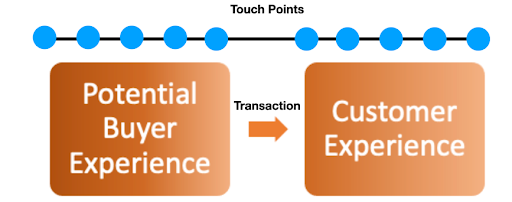The Audience Experience vs The Customer Experience

By Prebuilt Sites Team
October 10, 2022
As a brand, it’s all too easy to simply only focus on the customer experience and ignore the rest. The people who buy from you are your most important clientele, right? Yes and no. The customer is only a piece of the experience puzzle and if you want to better serve the customer you need to start thinking broader, in terms of the overall audience experience. The reality is, there are a lot of people who follow your brand, engage with your brand, and may never buy a product from you. But that doesn’t mean you shouldn’t still nurture them. As someone with a larger brand, I see that there are a lot of people who really adore my brand and everything it stands for. These people don’t always purchase my products, but they do recommend them to their friends and send potential customers my way. They’re loyal as hell and maybe one day down the line they’ll buy something from me. But in the meantime, I still love having their support and making sure they have a positive experience interacting with me. If you have any questions about customer experience, reach out to us at Prebuilt Sites or The BBS Agency. We’d love to help you out!
There’s no dispute Customer Experience (CX) is a hot topic these days and with good reason. But there is a potential problem that almost anyone responsible for improving customer experience is not thinking about. The customer is only a piece of the experience puzzle, and in this article, we’ll explain why you have to think broader than the customer experience in order to better serve the customer.
Every organization has multiple audiences with which they communicate and interact. In a recent project we led for a state-wide K-12 school system, the stakeholders readily identified upwards of 20 distinct audiences in less than 10 minutes. Each of those audiences has an experience — not just customers. We should be thinking about the audience experience (AX) more so than just the customer experience (CX).
Potential Buyer Experience Is NOT Customer Experience
For people who work on selling, they must focus on customer experience, or more accurately, the potential buyer experience. Examining your current customer journey map and see how much of it is really pre-transaction vs. post-transaction. There is nothing wrong with having the whole journey mapped out together but do recognize there are distantly different phases and different experiences associated with each touch point.

Source: Convince and Convert
In practice, once a potential buyer transacts—becomes a customer—often the customer experience ceases. Does your customer experience continue post-transaction to foster retention, loyalty, referrals, word-of-mouth, and advocacy? Those are the actual stages of the customer experience. In our observations, most truly defined “customer experience” efforts are really targeting the potential buyer experience.
Marketers Think Too Narrowly — But Should They?
Fans, followers, subscribers, are all audiences—but not all are customers.
This is where customer experience is generically too narrow as a category. Understand that each segment of audience or stakeholders must be narrowed down, so touchpoints can be designed for those specific audiences. Marketers tend to focus on the sales-related journey and experiences. That’s understandable and probably prudent. But, who else in your organization is focusing on all the other audiences and audience experiences that all contribute to organizational success?
One thing to consider: Customer service should heavily influence the customer experience. That may in fact roll up under marketing as it does include retention, cross-sell, and other factors contributing to life-time value.
Fans and Fandom — Why It Matters
You have audiences that are not customers and will never be customers. But they are still important and valuable.
Take fans for example. What does it mean to be a “fan”? Unlike the potential-customer experience, that audience has somegoal or desired outcome or a problem and is seeking a solution. Not so with fans.
You can have an audience of fans without them being customers. They engage and transact like the best customers, but they transact in loyalty and advocacy, not in dollars and cents. In your own life, are you a fan of a sports team, a musical group or performer, or a political candidate? The best fans don’t have to be customers, except they’re transacting with loyalty to the brand and what it stands for through their individual advocacy, amplification, and word of mouth. There is strength in numbers. The larger the fan following, the greater the collective voice becomes.
If your brand is any good at all, it has fans. No need to be a rock-star band, all brands have fans. The fan experience deserves strategic planning, too—not with the intent to turn it into a potential-customer experience, but rather to acknowledge, engage with, and grow the fan audience.
Which Audiences Matter Most?
Above we mentioned a particular higher ed organization with upwards of 20 audiences, and thus, about 20 audience experiencers to address. Consider your organization and your audience’s experiences. Beyond the prospective- and customer-experience, do you pay attention to the:
- Employee Experience
- Fan/Follower Experience
- Media/Influencer Experience
- Dealer or Reseller Experience (retail)
- Supplier/Vendor Experience (manufacturing)
- Investor/Donor Experience (fund raising)
- Parent Experience (higher education)
- Alumni Experience (higher education)
- Donor Experience (higher education)
We’ll stop short of 20 but you get the idea. With these and a few more relevant to your organization you can see lots of interconnected and essential opportunities to improve each experience overall and over time. Each audience, if important, needs attention to that overall experience, from inception to termination.
How Good Can CX Be Without a Great Employee Experience (EX)?
Well before the Great Resignation, employers vied to attract the best talent to achieve the business’s goals. It’s simply harder now when the talent pool is shrinking, and unemployment is low. Even so, often the talent you’re trying to attract is already employed elsewhere. This is where the employee experience really matters. Brian Solis, VP, Global Innovation Evangelist @ Salesforce writes, “The employee is also part of the customer experience. In fact, employee experience plus customer experience—EX+CX—is what will equal growth.”
“EX+CX—is what will equal growth.”
— Brian Solis
Ask your HR leader if they have a journey map that covers recruitment and onboarding and all the probable touch points that comprise the potential-employee and then employee experiences. Think of the value of each employee and the cost of replacing an employee. Think of the implication of a poor employee experience and how that may impact other areas of customer interaction. There is a real, measurable cost tied to a poor employee experience including the impact on the customer experience.
A well-tuned potential-employee experience and employee experience are powerful factors with many ripple effects impacting operations, revenue, and customer satisfaction. Conversely, a not-so-good employee experience is costly and an opportunity for the competition to steal away good talent and brain trust.
Great organizations strive to deliver great experiences.
What Next?
Do this:
- List 10 audiences with whom your organization interacts regularly. Specificity is key here, to help you in the next step.
- Rank them in order from the most essential to the lesser essential. Sure, they’re all going to be important or else you wouldn’t be interacting with them. Apply a filter based on which are most essential to the success of the business down to those that are perhaps tangentially necessary for success.
- On your list of 10, write in the name of the person in your organization responsible for each of those audience experiences.
- Ask those individuals to describe to you their process and method of measurement for the audience experience they own.
That fourth one is the kicker. If there is no process, no journey map for an audience, no definable plan for each interaction and outcomes, you have an operational liability. Great audience experiences don’t happen accidentally. It takes recognizing the need and making the investment to ensure those essential audiences all have the best experience possible. Great organizations strive to deliver great experiences.

